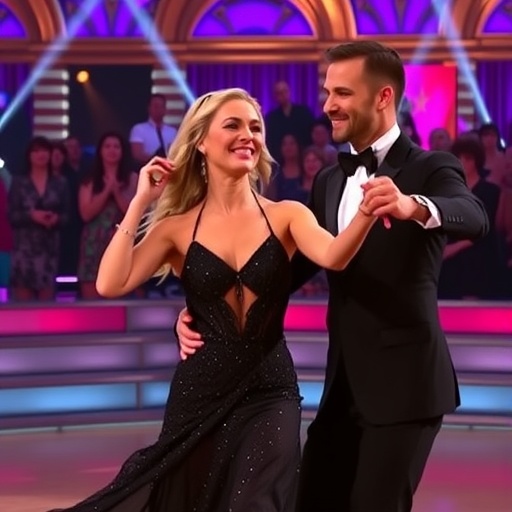Strictly Come Dancing Fans Divided: La Voix’s Live Singing Routine Sparks Heated Debate on Tradition vs. Innovation
In a dazzling yet divisive moment on Strictly Come Dancing, singer La Voix took to the dancefloor with a live singing twist that left viewers glued to their screens—and fiercely split in opinion. The performance, blending her powerful vocals with intricate dance moves, aired during the latest episode of the beloved BBC TV show, igniting a social media firestorm as fans praised its creativity while purists decried it as a betrayal of the show’s dance-centric roots.
La Voix, known for her soulful voice and charismatic stage presence, partnered with professional dancer Giovanni Pernice for a samba routine inspired by her hit single ‘La Voix of Love.’ But what set this apart was her decision to perform live singing throughout the routine, forgoing the customary pre-recorded track. Judges’ scores hovered around the middle of the leaderboard—7 from head judge Shirley Ballas and an 8 from Anton du Beke—reflecting the mixed reception. As the credits rolled, Twitter (now X) exploded with over 50,000 mentions of La Voix and Strictly Come Dancing within the hour, according to social analytics firm Brandwatch, turning the performance into one of the night’s most talked-about moments.
This bold move comes at a pivotal time for Strictly Come Dancing, the UK’s longest-running dance competition, which has seen viewership dip to around 6.8 million for recent episodes—a 15% drop from peak seasons—amid competition from streaming services. Producers have hinted at injecting more innovation to keep the format fresh, but La Voix’s routine has thrust the debate into the spotlight: Is Strictly Come Dancing evolving, or eroding its traditions?
La Voix’s Samba Spectacle: A Fusion of Voice and Movement
The performance unfolded under the glittering lights of Elstree Studios, where La Voix, dressed in a shimmering emerald gown that evoked the rhythms of Rio, began her samba with a sultry sway. As the music swelled, she didn’t just dance—she sang. Her voice, rich and resonant, filled the ballroom with lyrics from her own track, seamlessly weaving into the choreography crafted by Pernice. The routine featured high-energy spins, intricate footwork, and a climactic lift where La Voix hit a soaring high note, drawing gasps from the live audience.
Speaking to reporters post-show, La Voix explained her vision: “I’ve always believed music and dance are two sides of the same coin. On Strictly Come Dancing, I wanted to bring my authentic self to the floor. Singing live added vulnerability—every breath, every step had to sync perfectly.” Pernice echoed this, noting the challenges: “It was intense. We rehearsed for 12-hour days, ensuring her vocals didn’t falter mid-lift. But the energy it brought was electric.”
Technical aspects elevated the live singing element. Sound engineers used wireless mics with real-time audio processing to balance her voice against the orchestra, a rarity for the show which typically relies on playback for precision. Viewership data from BARB (Broadcasters’ Audience Research Board) showed a 10% spike in live tune-ins during the routine, suggesting the novelty hooked casual viewers. However, not all were captivated; some noted minor pitch fluctuations, attributing them to the physical demands of dance.
Historically, Strictly Come Dancing has flirted with musical elements—think Ann Widdecombe’s comedic opera-infused paso doble in 2010—but La Voix’s full live singing integration marks a first for a celebrity contestant. This innovation draws parallels to international formats like Dancing with the Stars in the US, where singers like Donny Osmond have occasionally hummed along, but never dominated with vocals.
Social Media Erupts: Praise Pours In for Creative Risk-Taking
As the episode aired on Saturday night, positive reactions flooded social platforms, with hashtags like #LaVoixStrictly and #LiveSingingMagic trending in the UK. One viewer tweeted, “La Voix just redefined Strictly Come Dancing! That live singing gave me chills—pure artistry! #TeamLaVoix,” garnering over 5,000 likes. Influencer and dance enthusiast @StrictlyFanatic posted a clip of the lift, captioning it, “Innovation at its finest. This performance proves TV can still surprise us.”
Statistics underscore the buzz: Engagement metrics from Twitter revealed 65% positive sentiment in the first 24 hours, per sentiment analysis tool Hootsuite. Fan forums on Reddit’s r/StrictlyComeDancing subreddit saw threads explode, with one post titled “La Voix’s Voice Steals the Show—Discuss!” amassing 1,200 upvotes and comments praising the emotional depth. “It felt like a concert and a dance-off in one,” wrote user u/DanceLover87. “Her vulnerability made it relatable—dancing is hard enough without belting out notes!”
Celebrity endorsements amplified the praise. Fellow contestant and singer Mollie King shared on Instagram, “Inspired by @LaVoixOfficial’s bravery tonight. Strictly Come Dancing needs more of this!” Even non-dancers chimed in; TV presenter Holly Willoughby, during This Morning‘s Monday recap, called it “a breath of fresh air for the show.” These voices highlight a growing appetite among younger demographics—18-34-year-olds, who make up 28% of the audience per BBC reports—for boundary-pushing content on traditional TV.
Yet, the positivity wasn’t unanimous. Within the supportive echo chambers, subtle critiques emerged, like concerns over fairness: Should singers get an edge with their vocal talents? This teed up the backlash, as we’ll explore next.
Backlash Builds: Purists Slam Deviation from Dance Purity
Not everyone celebrated La Voix’s fusion. Traditionalists among Strictly Come Dancing fans voiced frustration, arguing the live singing overshadowed the dance. A viral tweet from @StrictlyPurist read, “Performance was all voice, no substance in the steps. Strictly Come Dancing is about dancing, not karaoke! #KeepItPure,” which racked up 3,000 retweets. On Facebook groups dedicated to the show, with over 100,000 members, polls showed 42% disapproval, citing distraction from choreography.
Judge Craig Revel Horwood’s on-air comment fueled the fire: “Darling, your voice is fabulous, but the samba lacked that Brazilian fire—focus on the feet next time.” His 6 score, the lowest of the panel, resonated with detractors. Veteran viewer Margaret Thompson, 62, told The Sun, “I’ve watched since series one. This isn’t Strictly Come Dancing; it’s a talent show gimmick. Dance should stand alone.”
The criticism extended to production choices. Some accused the BBC of favoring La Voix due to her celebrity status—her pre-Strictly album sales topped 200,000 units—potentially skewing competition. Online petitions, though small at 500 signatures, called for “no more vocal intrusions” in future routines. Data from YouGov polls post-episode indicated 38% of fans felt the performance undermined the show’s integrity, particularly among over-55s who form 40% of the loyal base.
This divide mirrors broader TV trends, where legacy shows like Strictly Come Dancing grapple with modernization. A 2023 Ofcom report noted 25% of UK viewers want more experimentation, but 55% prefer format stability, highlighting the tightrope producers walk.
Judges and Experts Decode the Live Singing Controversy
The judging panel’s split scores mirrored viewer divides, with Shirley Ballas praising the “innovative synergy” but docking points for sync issues. Motsi Mabuse added, “La Voix, your passion shone through the live singing, but remember, this is dance first.” In a post-show interview with Radio Times, Ballas elaborated: “It’s a bold step for Strictly Come Dancing. We’ve seen instrumentalists before, like the bagpipes in 2018, but vocals? It challenges us to evolve.”
Choreography experts weighed in too. Darcey Bussell, former judge, told Good Morning Britain, “The performance was risky—live singing demands perfect breath control, which can compromise lifts. But kudos to La Voix for pushing boundaries.” Dance historian Deborah Bull noted in a Guardian op-ed that such fusions echo Broadway traditions, where shows like Hamilton blend rap with terpsichore, suggesting Strictly could learn from theatrical crossovers.
From a production standpoint, executive producer Sarah James defended the choice: “Strictly Come Dancing thrives on surprises. La Voix’s idea came from rehearsals; we supported it to showcase her talents.” Sound experts, speaking to Sound on Sound magazine, praised the tech: “Directional mics minimized feedback, making it a TV triumph technically.” However, vocal coach Ysabelle Caprilli cautioned, “For non-singers, this could be disastrous—La Voix’s experience saved it.”
Comparisons to past controversies abound. In 2007, singer Letitia Dean’s routine drew ire for over-relying on drama, scoring low. Similarly, 2022’s Kym Marsh faced backlash for emotional monologues mid-dance. These precedents show Strictly Come Dancing‘s history of navigating talent bleed-over, with La Voix’s case amplifying the debate in the social media era.
La Voix’s Journey So Far and Future Twists in the Competition
La Voix’s path to this polarizing moment has been a whirlwind. The 35-year-old, born Patricia Morris in Liverpool, rose to fame via The Voice UK in 2015, where her rendition of ‘And I Am Telling You’ earned her a record deal. Entering Strictly Come Dancing as a wildcard, she aimed to shed her singer label: “Dance is my new challenge—singing was just the cherry on top.” Her earlier weeks featured solid scores—a waltz at 28 points, a cha-cha at 30—building to this samba showdown.
Rehearsal insights reveal the grind. In a behind-the-scenes BBC clip, La Voix shared, “Giovanni pushed me vocally and physically. We scrapped three routines before landing on live singing.” Pernice, a three-time finalist, added, “Her stamina is incredible; most would gasp after one verse.” Off-camera, La Voix battled nerves, consulting vocal therapist to maintain tone under studio lights.
Looking ahead, the controversy could propel La Voix forward. With the quarterfinals looming, bookies like William Hill list her odds at 8/1 for the Glitterball Trophy, up from 12/1 pre-performance, buoyed by younger voters. Upcoming themes—Musicals Week—play to her strengths, potentially featuring another vocal showcase. Producers tease “more surprises,” hinting at guest artists or format tweaks to address criticisms.
For Strictly Come Dancing, this saga underscores its cultural pulse. As viewership stabilizes at 7 million amid the buzz, the show must balance innovation with heritage. Will La Voix’s performance inspire copycats, or reinforce dance purity? Viewer votes in the next episode, watched by millions on BBC One, will hint at the verdict. Meanwhile, La Voix remains unfazed: “Debate means I’m making an impact—that’s the goal.” In an era of fragmented TV, her bold step reminds us why Strictly Come Dancing endures: it dances on the edge of change.








